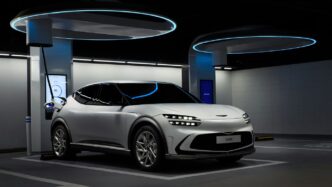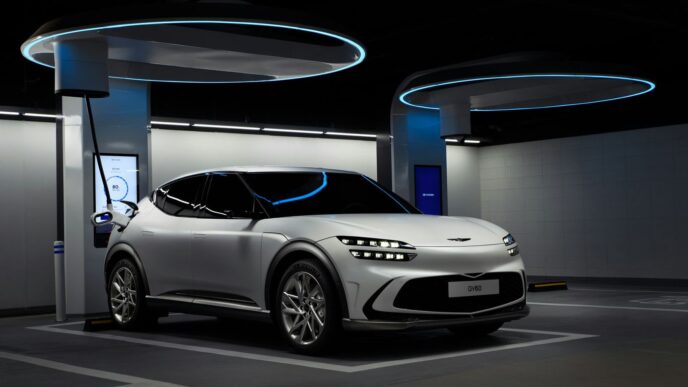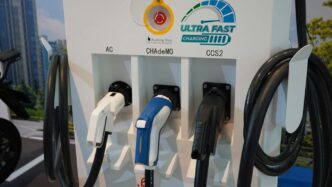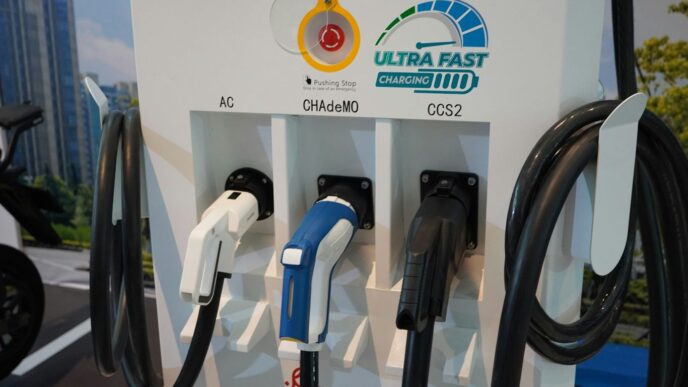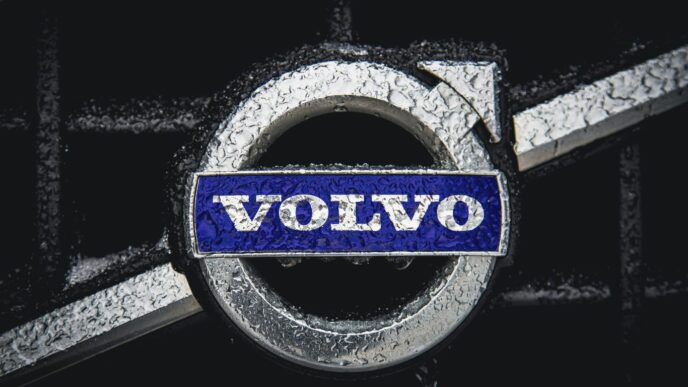So, you’ve got a Garchomp and you want it to be the best it can be. That’s awesome! Figuring out the best EVs for Garchomp can feel like a puzzle, but it’s totally worth it. We’re going to break down how to make your Garchomp a real powerhouse. It’s not just about slapping points everywhere; it’s about being smart with where you put them. Let’s get your Garchomp ready to dominate.
Key Takeaways
- When deciding on EVs, think about what you need your Garchomp to outspeed and which attacks it absolutely must survive. This helps prioritize where your points go.
- Don’t just blindly put 252 EVs into Attack and Speed. Sometimes, small tweaks can make a big difference, like surviving a specific hit or securing a KO.
- Consider investing EVs into Garchomp’s lower defensive stats. Even a small boost here can make it surprisingly more resilient than you might expect.
- Putting EVs into HP can be more effective than defenses if Garchomp’s base HP is already quite high, but it depends on the specific threats you’re facing.
- Pay attention to ‘EV bumps’ where 8 EVs can sometimes give you 2 stat points instead of 1, especially when using a boosting nature. This is a small optimization but can add up.
1. Understanding EV Basics
Alright, let’s talk about Effort Values, or EVs for short. These are basically hidden stats that your Pokémon gain as they battle and grow. Think of them as extra points you can assign to make your Pokémon even better at specific things. Every Pokémon can gain up to 510 EVs in total, and you can distribute these points across their six stats: HP, Attack, Defense, Special Attack, Special Defense, and Speed.
When you defeat a wild Pokémon or use certain items, your Pokémon earns EVs. The amount and type of EV gained depend on the Pokémon you fought or the item used. For example, beating a Zubat might give you Speed EVs, while using a Protein gives you Attack EVs. It’s a bit like training your Pokémon in a very specific way to boost their strengths or shore up their weaknesses.
Here’s a quick rundown of how they work at level 100:
- 4 EVs = 1 Stat Point. So, if you put 40 EVs into Attack, your Attack stat goes up by 10.
- You can only put a maximum of 252 EVs into a single stat.
- The total cap is 510 EVs across all stats.
Understanding this is the first step to really customizing your team. It’s not just about base stats anymore; it’s about fine-tuning your Pokémon for the specific role you want them to play. You can find more details on how Effort Values work if you want to dive deeper into the mechanics.
2. The Role of Nature
So, you’ve got your Garchomp, and you’re thinking about how to make it even better. EVs are a big part of that, but don’t forget about its Nature. Natures are like personality traits for your Pokémon, and they give a 10% boost to one stat while lowering another by 10%. This might not sound like much, but in the heat of battle, every little bit counts, right?
For Garchomp, we generally want to lean into its strengths. Since it’s already a speedy attacker, boosting its Attack or Speed is usually the way to go. A Nature that increases Attack and decreases Special Attack, like Adamant, is a solid choice. This lets Garchomp hit even harder with its physical moves. Alternatively, if you want Garchomp to outspeed even more threats, a Jolly Nature (boosting Speed, lowering Special Attack) is also a great option. It really depends on what you want Garchomp to do. Do you need it to hit like a truck, or do you need it to be the fastest thing on the field?
Here’s a quick look at the most common Natures for Garchomp:
- Adamant: +Attack, -Sp. Atk. Great for maximizing physical damage output.
- Jolly: +Speed, -Sp. Atk. Ideal for outspeeding more opponents.
- Impish: +Defense, -Sp. Atk. Less common, but can be used for a more defensive build if needed.
Choosing the right Nature is a key step in optimizing your Garchomp’s EV training. It sets the foundation for how you’ll distribute those precious Effort Values later on. Don’t just pick one randomly; think about how Garchomp fits into your team and what role you need it to fill. A well-chosen Nature can make the difference between a good Garchomp and a truly dominant one.
3. Prioritizing Speed

Alright, let’s talk about speed. In the world of Pokémon battles, going first can seriously change the game. Think about it – if you can land a hit before your opponent even gets a chance to move, you’ve already gained a massive advantage. For Garchomp, which is known for its offensive presence, making sure it’s fast enough to outspeed key threats is often a top priority. It’s not just about being faster than everything, though. We’re talking about specific Pokémon that Garchomp needs to outspeed to win matchups.
So, what does this mean for your EV investment? Well, you’ll want to allocate a good chunk of EVs into Speed. This usually means aiming for the maximum, 252 EVs, especially if you’re running a nature that boosts Speed, like Jolly (which increases Speed and lowers Attack).
Here’s a general idea of how Speed EVs can stack up:
- Base Speed: Garchomp’s base Speed is 102.
- With 252 Speed EVs and a Jolly Nature: This pushes Garchomp’s Speed stat significantly higher, allowing it to outpace a lot of common threats.
- Target Speeds: You’ll want to identify the Pokémon you absolutely must outspeed. This could be other fast attackers, Pokémon that set up hazards, or even certain defensive Pokémon that you need to hit hard before they can wall you.
It’s a balancing act, of course. You can’t just dump all your EVs into Speed and ignore everything else. But if outspeeding a particular Pokémon means the difference between winning and losing a common matchup, then investing those Speed EVs becomes a really smart move. Don’t just blindly put EVs into Speed, though; think about who you need to outspeed and why. That targeted approach is what really makes a difference.
4. Surviving Key Attacks
Okay, so we’ve talked about speed and hitting hard, but what about not getting knocked out in the first place? Garchomp, while fast and strong, can’t just ignore incoming damage. Sometimes, the difference between winning and losing comes down to whether you can take one more hit. This is where thinking about specific attacks you absolutely need to survive becomes super important.
It’s not about being a wall for every single attack, that’s just not realistic. Instead, identify the most common or dangerous threats that Garchomp faces. Are you worried about a specific Water-type move? Or maybe a powerful Ice-type attack? Knowing these helps you decide where to put those precious EVs.
Let’s look at some common scenarios:
- Surviving a common super-effective hit: For example, if a particular Fairy-type move is giving Garchomp trouble, you might invest enough EVs in Special Defense to guarantee you live that hit. This allows you to retaliate or switch out safely.
- Living a neutral hit from a strong attacker: Sometimes, even a neutral hit from a Pokémon like Iron Hands can be a problem. A small investment in Defense might let you survive that hit and use a move like Swords Dance or Earthquake.
- Outlasting a status move: While not strictly an ‘attack’, surviving a turn to avoid a crippling status like Toxic or Will-O-Wisp can be just as vital. Sometimes, a few extra HP or Defense EVs can mean the difference between being crippled and being able to act.
The goal here is to make Garchomp resilient enough to handle specific threats, turning potentially losing matchups into more manageable ones. It’s about calculated risks and making sure Garchomp can do its job even when under pressure. Don’t just blindly dump all EVs into Attack or Speed; consider what Garchomp needs to stay on the field to do its work.
5. Achieving Specific KOs
Sometimes, you’ve got a specific opponent in mind that you really want your Garchomp to take down in one hit, or maybe two. This is where thinking about specific KOs comes into play. It’s not always the top priority, mind you. Often, just barely missing out on a KO is fine if it means your Garchomp is better overall in other areas. But if there’s a common threat that you can reliably knock out with a bit of extra Attack investment, it’s definitely worth considering.
Let’s say you’re looking at a common threat like a bulky Water-type that Garchomp often struggles against. You might run some damage calculations. If adding just a few more EVs into Attack lets your Earthquake or Dragon Claw hit that specific Pokémon hard enough to secure a KO when it previously wouldn’t have, that’s a pretty big deal. It can turn a situation where you might get knocked out into one where you take them down first.
Here’s a quick way to think about it:
- Identify Key Threats: What Pokémon does your Garchomp need to beat quickly?
- Run Damage Calcs: Use online tools to see how much damage your Garchomp’s moves do to those threats with different EV spreads.
- Evaluate the Investment: Does a small shift in EVs make a big difference in KO potential? Is that difference worth it compared to other stat investments?
Focusing on securing a specific KO can sometimes be the difference between winning and losing a match. It’s about making your Garchomp as effective as possible against the Pokémon it’s most likely to face.
6. Investing in Low Stats
So, we’ve talked about beefing up Garchomp’s strengths, but what about its weaknesses? Sometimes, putting effort into stats that are already pretty low can actually give you a bigger bang for your buck. Think about it like this: if you have a stat that’s already sky-high, adding a few more points might not change much. But if a stat is really struggling, even a small boost can make a noticeable difference.
For Garchomp, its Special Defense isn’t exactly its strong suit. While we usually want Garchomp hitting hard and fast, there are times when surviving a surprise special hit can be the difference between winning and losing. Investing EVs here might not make Garchomp a special wall, but it could help it take a hit it otherwise wouldn’t.
Here’s a general idea of how it works:
- Low Base Stat: When a stat is naturally low, EVs have a more significant impact. For example, if Garchomp’s Special Defense is 50, adding 252 EVs might raise it to 100. That’s a big jump!
- High Base Stat: If a stat is already high, say 100, adding 252 EVs might only bring it up to 150. Still good, but the percentage increase is smaller.
This means that shoring up a weak defensive stat on Garchomp can be more efficient than trying to make an already strong offensive stat even stronger. It’s all about finding those spots where your EV investment really counts.
7. Investing in High Stats
So, we’ve talked about beefing up the weaker parts of Garchomp, but what about its already strong stats? Sometimes, pouring those hard-earned EVs into what Garchomp already does well makes a lot of sense. Think about its Attack stat. While adding EVs to a high stat might not give you as big a percentage boost as adding them to a low stat, it can be the difference between landing a knockout blow and just chipping away at your opponent’s HP.
For Garchomp, that Attack stat is already pretty decent. If you’re running a more offensive set, pushing that Attack even higher can be super important. It might mean you can finally take out that pesky Pokémon that always gives you trouble, or it could help you secure a win faster. It’s all about those specific matchups and what you need Garchomp to accomplish.
Here’s a quick look at how those EVs can add up:
| Stat | Base Value | 252 EVs Added | Total (Approx.) |
|---|---|---|---|
| Attack | 150 | +32 | 182 |
| Speed | 102 | +32 | 134 |
Don’t underestimate the power of these small gains; they can absolutely swing battles in your favor. It’s not just about hitting harder, though. If you’re focusing on speed, adding those EVs can help Garchomp outpace threats that would otherwise be a problem. It really comes down to your specific strategy and what role you want Garchomp to play on your team. Sometimes, making a good stat even better is the smartest move you can make.
8. HP vs. Defense EVs
So, you’ve got your Garchomp, and you want it to be tough. That brings up a common question: should you dump your EVs into HP or its Defense and Special Defense stats? It’s not always a simple answer, and honestly, it depends on Garchomp’s base stats and what you’re trying to achieve.
Generally speaking, putting EVs into HP gives you a more noticeable boost across the board compared to putting them into Defense or Special Defense, especially if those base stats are already pretty decent. Think of it like adding more water to a bucket – the whole bucket gets fuller. However, if Garchomp had a really low base Defense but a sky-high HP stat, then investing in that weak Defense might actually make a bigger percentage difference, making it more viable.
Let’s look at it this way:
- HP EVs: These boost your overall survivability. More HP means you can take more hits before fainting, regardless of whether they’re physical or special. It’s a straightforward way to increase bulk.
- Defense/Special Defense EVs: These specifically shore up your weaknesses. If Garchomp is getting knocked out by strong physical attackers, investing in Defense makes sense. If special attackers are the problem, then Special Defense EVs are your go-to.
Sometimes, the choice comes down to specific threats. You might want Garchomp to survive a particular powerful attack from an opponent. Calculating if investing in HP or one of the defenses will let you live that hit is key. For instance, if a specific special attack is OHKOing Garchomp, but adding 252 EVs into Special Defense allows it to survive, that’s a huge win. The same applies if a physical attack is the issue and Defense EVs are needed.
Ultimately, for Garchomp, focusing on HP is usually the safer bet for general bulk, but don’t be afraid to tweak your Defense or Special Defense EVs if you’re consistently getting KO’d by a specific type of attack. It’s all about making Garchomp as resilient as possible against the threats you expect to face.
9. The Impact of IVs
Alright, so we’ve talked a lot about EVs, right? But there’s another piece of the puzzle that’s super important, and that’s IVs. Think of IVs as your Pokémon’s natural talent, its inherent potential. They’re set when you get the Pokémon and don’t change, unlike EVs which you can train.
The biggest thing to remember is that IVs directly affect how much benefit you get from your EVs, especially at level 50. At level 100, every 4 EVs give you 1 stat point. Simple enough. But at level 50, which is what most competitive battles use, it gets a bit trickier. If your IV for a stat is an odd number (like 31), you’ll get a stat boost every 4 EVs initially, then every 8 EVs. But if your IV is an even number (like 30), you only get boosts every 8 EVs. This means a Pokémon with a 30 IV in a stat will never quite reach the same stat total as a Pokémon with a 31 IV in that same stat, even with the exact same EV investment. You can’t max out a stat with a 30 IV, which is a pretty big deal.
So, what does this mean for Garchomp? You absolutely want 31 IVs in Speed, Attack, and HP. For its defensive stats, it’s a bit more flexible. If you’re not investing any EVs into Defense or Special Defense, a 30 IV is fine because it’ll have the same stat as a 31 IV with zero EVs. But as soon as you put any EVs into those stats, that 30 IV starts to hurt you compared to a 31 IV. It’s a small difference, but in competitive play, those small differences can decide battles.
Here’s a quick rundown:
- Attack, Speed, HP: Aim for 31 IVs. These are your primary offensive and survival stats, and you want every bit of help you can get.
- Defense & Special Defense: 31 IVs are ideal, but 30 IVs can be acceptable if you’re not planning to invest EVs in them. Just be aware that any EV investment will make the 31 IV superior.
- Special Attack: Garchomp usually doesn’t focus on Special Attack, so you can often get away with a lower IV here if you’re trying to save on breeding costs or if you’re using a specific set that doesn’t need it. However, if you’re going for a mixed set, you’ll want 31 IVs here too.
Basically, don’t skimp on IVs, especially for the stats you’re actively training with EVs. It’s the foundation upon which your EV training builds.
10. Utilizing EV Bumps

So, you’ve got your Garchomp’s EVs all planned out, right? But have you thought about those tiny, almost hidden stat boosts you can get? They’re called "EV bumps," and they’re a neat little trick for squeezing out extra performance. Basically, when you invest EVs into a stat that’s already boosted by your Garchomp’s Nature, you sometimes get two stat points for every eight EVs instead of the usual one. It’s not a huge difference, but over time, it can add up.
Think of it like this:
- Normally, 8 EVs = 1 stat point.
- With a "bump," 8 EVs can = 2 stat points.
These bumps usually happen a few times between 0 and 252 EVs in a stat. It’s a small optimization, sure, but if you’re not sure where to put those last few EVs, hitting one of these bumps can be a good way to go. It’s all about making every single EV count, especially when you’re aiming for that competitive edge. For a more in-depth look at how these spreads work, you might want to check out this guide on optimal Garchomp builds.
It’s not something you’ll always need to worry about, especially if you’re just starting out. But for those who want to really fine-tune their Pokémon, understanding these EV bumps can be the difference between a good Garchomp and a truly dominant one. It’s these little details that often separate the best from the rest.
Wrapping It Up
So, we’ve gone over how to really fine-tune your Garchomp with specific EV spreads and some smart strategies. It might seem like a small detail, but getting those stats just right can make a huge difference in battles. Thinking about what you need your Garchomp to do – whether it’s outspeeding a certain threat or surviving a big hit – really helps you figure out where to put those precious EVs. Don’t be afraid to experiment and tweak things based on the Pokémon you’re facing. Getting your Garchomp to perform at its best is all about understanding these little details and making them work for you. Thanks for sticking with me through this guide!
Frequently Asked Questions
What are EVs and how do they work?
EVs, or Effort Values, are like hidden points that your Pokémon earn by battling. At level 100, every 4 EVs add 1 point to a Pokémon’s stat. At level 50, which is common in many games, it’s 8 EVs for 1 stat point. Think of them as extra training points you can give to your Pokémon to make them stronger in specific areas.
Why is my Pokémon’s Nature important for EVs?
Your Pokémon’s Nature gives a 10% boost to one stat and a 10% decrease to another. When you put EVs into a stat that’s already boosted by its Nature, you might get a little extra boost, sometimes gaining 2 stat points instead of 1 for a certain amount of EVs. It’s a small trick to get even more out of your training.
Should I focus on Speed or Defense EVs for Garchomp?
It really depends on how you want to use Garchomp! If you want it to attack before your opponent, you’ll want to invest heavily in Speed. But if you want Garchomp to withstand strong hits, putting EVs into its defenses or HP will make it much tougher. It’s a balancing act!
What’s the deal with prime numbers and defense stats?
Some players believe that having defense stats that are prime numbers (numbers only divisible by 1 and themselves, like 7, 11, or 13) can sometimes lead to taking slightly less damage. It’s thought to be because of how the game calculates damage with fractions. It’s a bit of a niche strategy, but it might help in certain situations.
When should I invest EVs into low stats instead of high stats?
Investing EVs into stats that are naturally low can have a bigger impact. For example, adding defense EVs to a Pokémon with very low defense might make it noticeably tougher. For Pokémon that are already strong attackers, adding EVs to their attack stat might not seem as dramatic, but it can be crucial for landing a knockout blow.
How do IVs affect my EV training?
IVs, or Individual Values, are like a Pokémon’s natural talent in each stat, ranging from 0 to 31. When you train EVs, having an IV of 31 is usually best. If your IV is lower, like 30, you might not get the full benefit from your EVs in that specific stat, especially at level 50. It’s like having a slightly less efficient training session.









